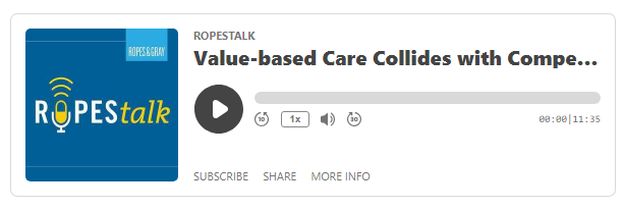On this episode of Ropes & Gray's Value-based Care Collides with Competition podcast series, private equity partner Marty Ruhaak is joined by health care attorneys John Saran and Meg Lewellyn to discuss the practical effects of recent federal and state government efforts to scrutinize private equity-funded health care entities and state legislative developments to impose oversight over health care transactions involving private equity-funded entities.
On the Value-based Care Collides with Competition series, Ropes & Gray attorneys explore how aggressive federal and state enforcement of antitrust and other competition laws appears to be in tension with the nationwide shift to value-based care models.
The series examines how the adoption of new state competition, quality, access and cost laws is creating additional burdens on health care entities, including private equity-backed entities and management services organizations, that are considering new transactions—and how to mitigate the impact of these potential impediments. For more on this topic, please visit our resource center with dedicated resources on the changing regulatory landscape.
Transcript:
Meg Lewellyn: Hi, and welcome to today's podcast. My name is Meg Lewellyn, and I'm an associate in Ropes & Gray's health care practice group where I focus on health care transactions and regulatory matters. With me today are Marty Ruhaak and John Saran. Marty is a partner in Ropes & Gray's private capital transactions group where he represents clients throughout the private equity industry and specializes in designing deal structures that help clients optimize value and navigate strategic opportunities in diverse industries. John is counsel in Ropes & Gray's health care practice group where he advises and represents health care companies, private equity investors, and other strategic investors in guiding these entities through complicated mergers and acquisitions and public offerings.
Meg Lewellyn: I want to start with the recent history of increased government interest in private-equity-funded health care entities. John, when did we see this interest ramp up?
John Saran: Thanks, Meg. After the change in the last administration, we saw a shift begin in August of 2021 when the U.S. Senate Finance Committee (the "Committee") launched an inquiry into a for-profit hospice company. The Committee's main inquiry was wondering how the private equity model and the hospice care model aligned. In the letter notifying the company of the inquiry, the Committee expressed a need for more information on what they characterized as a unique business dynamic where the desire to generate profits could be sought at the expense of dying patients and their families. While the Committee acknowledged there are other private-equity-funded health care entities out there, the Committee particularly questioned this model in the hospice industry. The Committee cited a Health Affairs study that claimed private equity investment throughout the country's health care system has increased twentyfold in the past two decades.
Meg Lewellyn: Thank you, John. What kind of information did the Committee seek?
John Saran: In addition to various hospice-industry-specific metrics, the Committee required a list of every private equity fund that had invested since 2011 as well as the investment date, total amount invested, resulting ownership stake, and the date of divestment (if applicable).
Meg Lewellyn: That seems like quite the deep probe. Where did the Committee or other federal government bodies look to next?
Marty Ruhaak: The Committee did not engage in any further public activity toward PE-backed health care entities, but after President Biden's State of the Union address in March of 2022, we saw the federal government's focus shift to private equity ownership of nursing homes.
Meg Lewellyn: Interesting. Do we know the impetus for focusing on nursing homes next?
Marty Ruhaak: Right before the State of the Union address, the White House released a fact sheet that shined a spotlight on the unprecedented numbers of deaths in the nursing home industry during the pandemic. As part of that, the Administration cited a study that showed private equity owned 5% of the nursing home market in 2018. The Administration's research suggested that resident outcomes were worse in private-equity-owned nursing homes and that such private-equity-owned nursing homes also led to increased Medicare costs. Accordingly, the Biden Administration and the Centers for Medicare and Medicaid Services announced their plan to conduct a multi-prong effort to improve quality of care, protect residents and employees, and to take actions against "bad actors."
Meg Lewellyn: Interesting. So, what have we seen CMS and other federal agencies do to target private equity in these efforts?
John Saran: Good question, Meg. In February 2023, CMS published an official Proposed Rule that would require nursing home facilities to report ownership and management information.This is the information that CMS noted they are specifically trying to gather on private equity firms. Again, they cited the increase in private-equity-funded nursing homes as correlative to the decline in nursing home quality. Relatedly, two months later in April 2023, the Department of Health and Human Services released ownership data for all Medicare-certified hospices, home health agencies, and skilled nursing facilities to outline each entity's ownership type, among other related facts.1
Beyond this, it is worth noting that the Federal Trade Commission is known to have a hostile view of private equity firms and has been concerned about strategies employed by PE firms to "roll up" physician practices through multiple acquisitions below the HSR (Hart-Scott-Rodino) notification threshold. Not surprisingly, the FTC has warned about increased enforcement in this area.
Meg Lewellyn: John, thank you for that overview. As I understand it, the federal government is not alone in its desire for more transparency with private-equity-funded health care entities. Have state governments hopped on the trend?
Marty Ruhaak: Yes, and in a very large way. Over the past few years, we have started to see a rise in states enacting laws aimed at regulating health care access, cost, and quality. And to help distill the range of state law enactments, we have released this podcast series detailing these state laws as they have crept up on the West Coast and the East Coast. There, we define what types of transactions each state law captures, what entities need to be involved, what penalties may be associated, and what we view as the current and potential enforcement landscape. Overall, our research found that many state governments have enacted laws granting state officials the power to review—and potentially block—many types of health care transactions under the notion that the transaction may significantly and/or adversely affect health care access, cost, and quality.
Meg Lewellyn: Thank you, Marty. And, as our focus today is how these changes affect private equity's participation in health care transactions, do you see any state law enactments focusing on private equity similar to the federal government's recent actions?
Marty Ruhaak: We do, as a matter of fact. Oregon's law provides the most explicit reference to PE by including private equity firms holding a 25% or greater interest in a health care entity within its definition of "health care entities" subject to review. We see this intent directly play out in those transactions Oregon reviews; two of the eight completed transactions reviewed to date involve private equity firms. Although both of those transactions were approved without conditions, Oregon's body of review—the OHA—used its public review summaries to highlight outside research and interest group commentary on the alleged negative effects of private equity's ownership and control of health care entities as well as the federal government's recent probe into ownership and control of health care entities.
Meg Lewellyn: Interest group commentary—what is the connection between these interest groups and the reviewed transaction that would warrant the inclusion of their commentary in this report?
Marty Ruhaak: That's a good catch. When the transacting parties submit notification of their transaction to OHA, Oregon allows third parties to submit official comments regarding the proposed transaction. These third parties are often interest groups such as the Oregon State Public Interest Research Group and SEIU Local 49. Both groups were in favor of Oregon's law and the increase in oversight and against the transactions under review. In particular, both groups heavily criticized private equity's role in the transactions because of what they characterized as significant misalignment in business practices and financial goals between private equity firms and health care entities.
Meg Lewellyn: Have we seen OHA acknowledge these comments from public interest groups and take specific actions against private-equity-backed health care companies?
Marty Ruhaak: Yes, we have—Oregon cited two specific reports of concerns. One was regarding how private equity's billing practices may seek to maximize profits at the expense of patient experience and the second cautioned how private equity's cost-cutting strategies may reduce an entity's quality of care. OHA gave no opinion on the merits of those reports but indicated it will monitor the transaction's impact on health care spending and quality outcomes in follow-up reviews of these transactions.
Meg Lewellyn: This regulation seems like it will have a massive impact on deal structure, cost, and timing for private-equity-backed deals with an Oregon presence, but John, are we seeing other states follow Oregon's lead?
John Saran: Yes and no, Meg. While states have proposed bills that could pick up private-equity-backed deals, only a few thus far directly call out PE. One interesting example is the published model act for state oversight of proposed health care mergers put out by the National Academy for State Health Policy in November 2021—this included a specific call out to health care transactions involving private equity firms. Now, Maine recently proposed a bill with this language, but the bill is still in very early stages.2 Despite these examples, other states proposing similar policies are careful not to directly call out PE.3 For example, New York state recently passed a law implementing pre-closing notice requirements for qualifying "material transactions." While earlier versions of this law outlined the intention to capture "investor-backed" platforms, this particular language was removed in the final version.
Meg Lewellyn: Thank you, John. New York being home to some of the largest private-equity-backed physician practice deals we have seen to date, this new law could have huge implications for future private equity deals, even without the "investor-backed" language. What's next?
Marty Ruhaak: At this time, it's difficult to tell. As we discussed in the East Coast podcast, New York state only requires notice of transactions, but the information submitted will become public. There is a chance that the New York AG could bring actions to impede transactions, but we do not anticipate that happening at this time. In time though, New York state could pass a more comprehensive version of the law to require approval. Even though the current law is watered down from its original proposal, we still need to see the related regulations and how it will be enforced. When the law first passed, we received several calls and emails from concerned private equity investors.
Meg Lewellyn: Thank you, Marty. New York's choice to narrow its authority in the final version is an interesting turn. John, are there any exceptions that might be helpful for your private equity clients?
John Saran: In the enacted version, there is an exception for "de minimis" transactions, which are considered those transactions that result in a health care entity increasing its total gross in-state revenues by less than $25 million. However, the wording of this carve-out is ambiguous. When a private equity company first acquires a health care entity or sells it to a third party, the revenue of such health care entity does not increase. That's particularly the case in the management services organization context. So, can this exception provide peace of mind for private equity firms buying and selling health care entities? This exception would also be helpful in the add-on context where portcos could acquire smaller platforms so long as the resulting increase in revenue was under the $25 million threshold.
Meg Lewellyn: Very interesting point, John. Do you expect any resolution on this any time soon?
John Saran: I would expect that this is clarified in the regulations or guidance, so it will be important to continue following this process.
Meg Lewellyn: From everything we discussed, it seems private-equity-backed health care entities could be at the crosshairs of the federal and state government for the next few years. How would you both advise private equity companies seeking to continue working in the health care space?
Marty Ruhaak: We are still in the early stages of many of these state laws, so it will take time for the state agencies to refine their enforcement priorities and overall goals of their programs. If they overstep too far and capture several broader national platforms, then it will only be a matter of time before we see parties challenge their authority and those programs. On the federal side, it seems the focus is on nursing homes, but we will see where the enforcement tide goes next.
John Saran: Taking into account both what we do know and what is still pending, I think the best advice is to focus investment in operations that promote better quality of care, access to care in underserved markets, and lower costs to patients.
Meg Lewellyn: Great points, John and Marty. Thank you both again for lending your time and expertise to this conversation. If those listening would like more information on this topic or our private capital transactions or health care groups, don't hesitate to contact us or visit our resource center, where we house a list of every podcast in this series. Other Ropes & Gray podcasts are available to listen and subscribe to wherever you regularly find your podcasts, including Apple, Google, and Spotify. Thanks again for listening.
Footnotes
1. On May 11, 2023, the U.S. House of Representatives introduced a bill that would require hospitals, freestanding emergency centers, ambulatory surgical centers, physician practices with more than 25 physicians, physician practices owned by hospitals, insurance companies, and other similar entities to disclose ownership data upon a change in ownership to the Department of Health and Human Services who would use this to analyze healthcare consolidation and transactions trends. H.R. 3262, 118th Cong. (2023-2024).
2. Despite initial inertia in Maine's legislature, the bill failed a vote on Wednesday, May 24, 2023, but the bill's fate did not appear to have been caused by its reference to private equity. Instead, the Maine AG criticized the bill for the significant administrative burden it would place on the AG's office. An Act to Improve State Oversight of Proposed Health Care Entity Transactions: Hearing on H.P. 894 Before the Comm. on Health Coverage, Ins. & Fin. Servs., 2023 Leg., 131st Sess. (Me. 2023) (written statement of Att'y Gen. Aaron M. Frey) (https://legislature.maine.gov/legis/bills/getTestimonyDoc.asp?id=10023174)
3. For example, recently passed laws in Illinois and Minnesota, a bill in Pennsylvania, and an amendment to the existing law in Washington all carefully avoid calling out private equity. See Ill. H.B. 2222; Minn. H.F. 402; Pa. S.B. 548; Wash. S.B. 5241.
The content of this article is intended to provide a general guide to the subject matter. Specialist advice should be sought about your specific circumstances.




